Key takeaways:
- Biodiversity in gardening supports ecosystem health, pest control, and soil fertility through diverse plant selections.
- Practices like companion planting and creating wildlife habitats enhance garden ecosystems, attracting beneficial insects and pollinators.
- Gardening teaches valuable lessons in patience, resilience, and the joy of diversity through hands-on experiences and experimentation.
- Sharing gardening knowledge inspires sustainable practices in communities and engages future generations in understanding biodiversity.
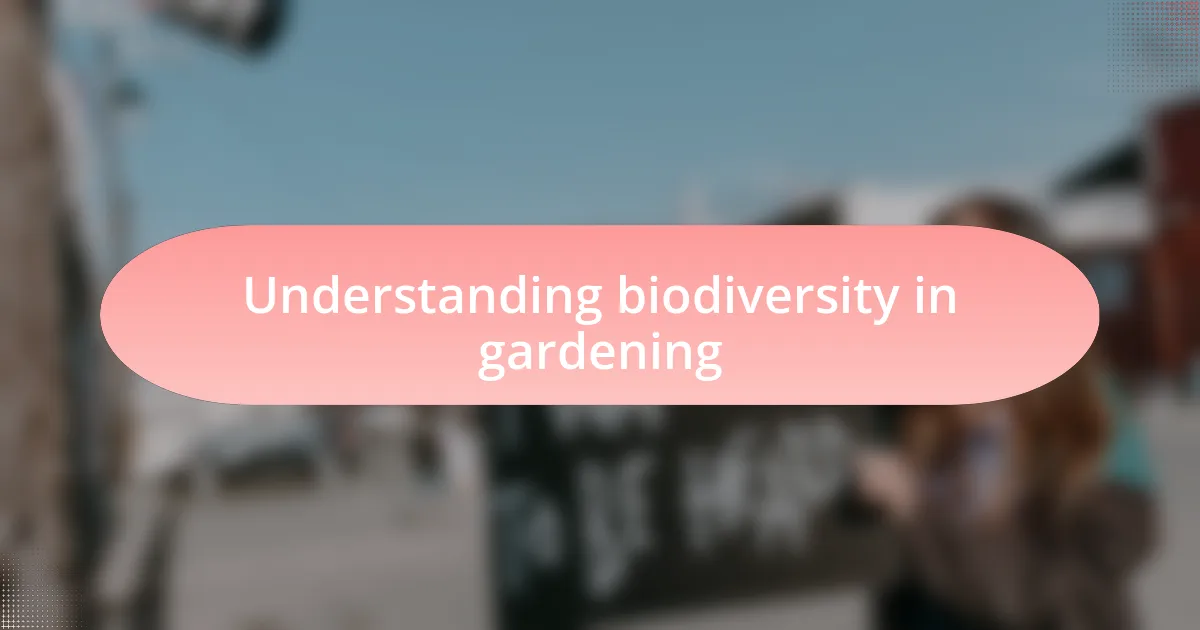
Understanding biodiversity in gardening
When I first started gardening, I instinctively understood that a garden wasn’t just a collection of plants; it was a living ecosystem. This realization came to me on a day when I noticed how the butterflies danced from one flower to another, each pollinator playing its part in a delicate balance. Isn’t it fascinating how each species, big or small, contributes to the vibrant tapestry of life in our gardens?
Biodiversity in gardening goes beyond visual beauty – it plays a critical role in pest control and soil health. I remember planting a diverse array of herbs alongside my vegetables, and surprisingly, the pest population plummeted. It was a game-changer for me; it felt rewarding to know that nature had its mechanisms to maintain balance, simply by creating a varied environment.
Every time I see a bird nesting in the shrubs I planted, I feel a sense of fulfillment that goes beyond aesthetics. I wonder how many of us realize that our gardening choices can have wider implications for local wildlife. By choosing native plants or creating habitats, I’ve observed not just an increase in visitors, but a thriving community that makes my garden feel alive. Isn’t it incredible to think that our actions can nurture biodiversity right in our backyards?
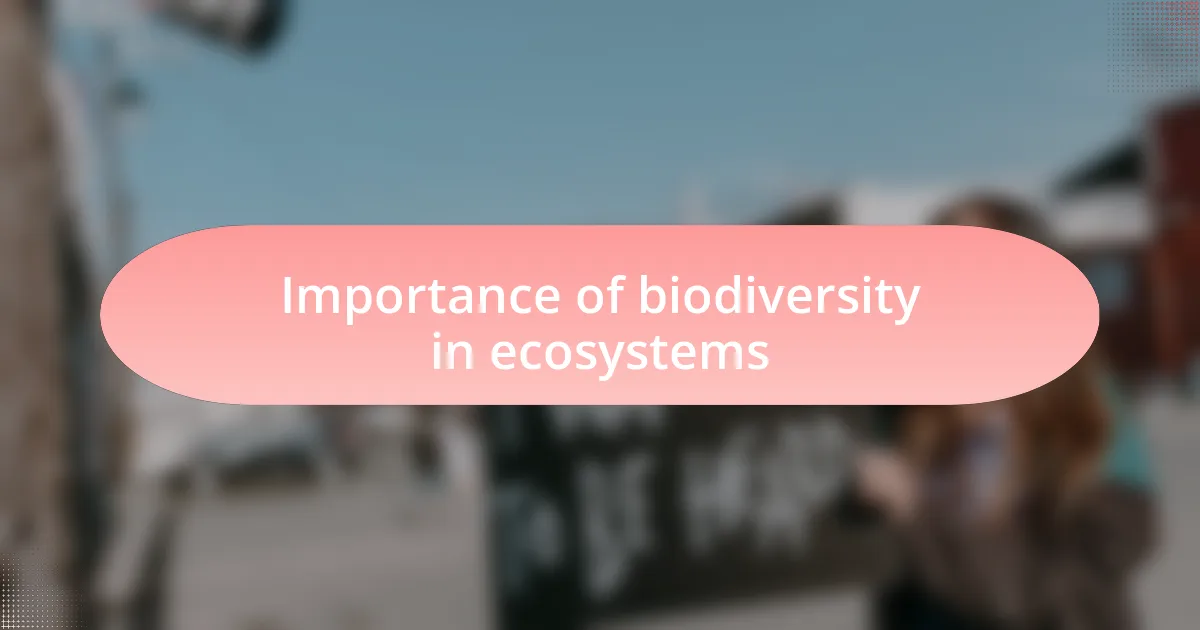
Importance of biodiversity in ecosystems
Biodiversity is essential for the resilience of ecosystems. Each species, whether it’s a tiny insect or a towering tree, plays a unique role in maintaining ecosystem health. I often think about my vegetable garden and how the abundance of different plants attracts various insects. This diversity not only brings life but also helps in pollination and nutrient cycling, creating a robust environment.
From my experience, a lack of biodiversity can lead to fragile ecosystems that are more susceptible to stressors like pests and diseases. I recall a season when I only planted one type of vegetable; not only did my harvest suffer, but the entire garden seemed to lose its vibrancy. Isn’t it interesting how our gardening practices can either bolster or weaken this delicate balance?
Healthy ecosystems with rich biodiversity offer critical services, such as clean air and water, which directly impact human well-being. As I enjoy my morning coffee in the garden, I’m reminded of the intricate connections formed by diverse life. It’s a beautiful revelation that maintaining biodiversity can enhance our quality of life, wouldn’t you agree?
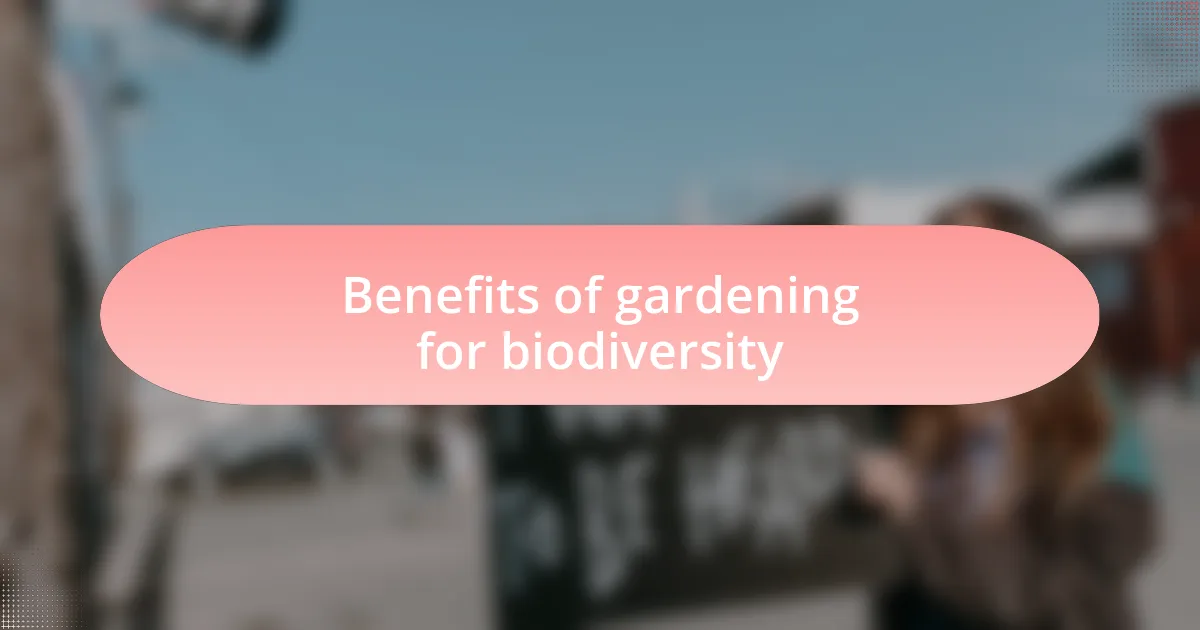
Benefits of gardening for biodiversity
Cultivating a garden can significantly benefit biodiversity, and I’ve seen this firsthand in my own space. When I introduced native plants alongside my vegetables, I noticed a delightful increase in birds and beneficial insects. It’s fascinating how these additions not only beautified my garden but also created a thriving ecosystem, rich with life. Have you ever paid attention to the way native plants seem to weave a vibrant tapestry of interactions?
Moreover, every time I compost kitchen scraps and enrich my soil, I’m struck by how this practice nurtures microorganisms essential for plant health. I feel a sense of satisfaction knowing that I’m supporting life beneath the surface. This connection can be quite profound—when soil teems with diverse life, it leads to healthier plants which, in turn, can provide food and habitat for even more creatures. Isn’t it amazing how these small actions can create a ripple effect throughout the environment?
Sharing my garden with a variety of species has also taught me about balance. During one particularly hot summer, I noticed that the mix of different plants helped maintain moisture levels in the soil. This experience highlighted the importance of plant diversity in creating microclimates that can support a wider range of life. Don’t you think that embracing diversity in gardening is not only good for plants but also for the entire ecosystem that depends on them?
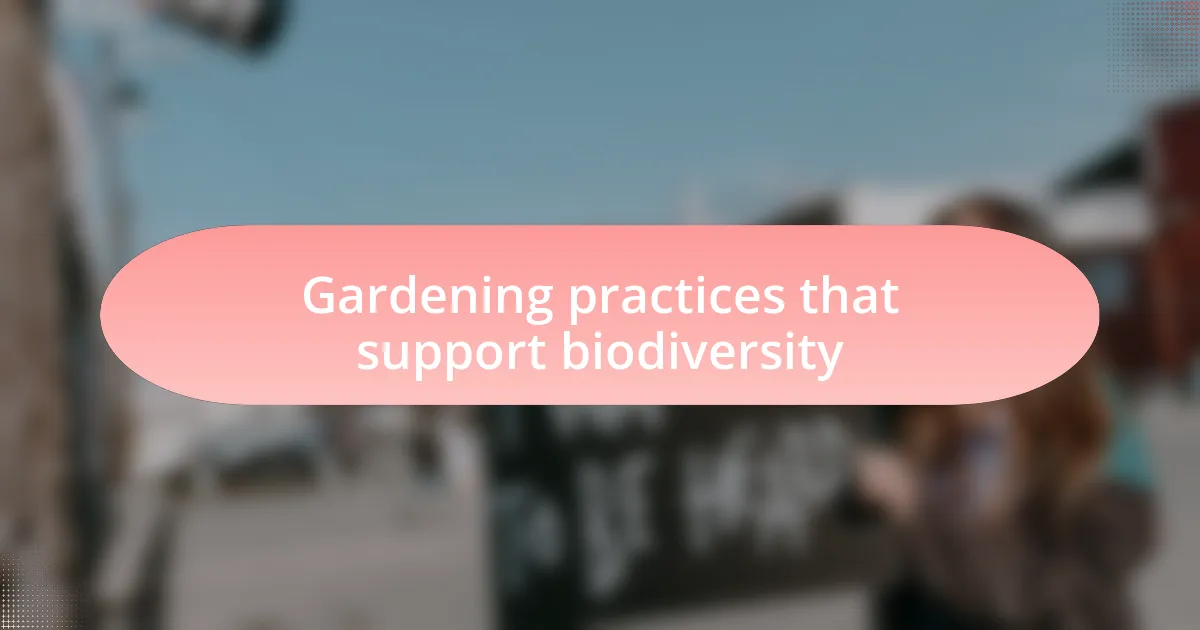
Gardening practices that support biodiversity
One effective practice I’ve embraced is companion planting. For example, I used marigolds alongside my tomatoes, and what a revelation it was! Not only did the marigolds enhance the tomatoes’ flavor, but they also attracted beneficial insects that kept pests at bay. Have you ever tried pairing plants in ways that just seem to naturally complement each other? It’s remarkable how these simple choices can lead to a more vibrant and balanced garden ecosystem.
Another strategy I found beneficial is encouraging wildlife habitats. I’ve set aside a small corner of my garden as a wildflower patch, which attracts not only bees but also butterflies and other pollinators. Watching these creatures flit around brings so much joy, and it feels like I’m fostering a little sanctuary right in my backyard. Isn’t it rewarding to know that by letting a part of your garden be wild, you’re inviting life into your space in such an engaging way?
Incorporating sustainable practices has also been a game-changer for me. For instance, I’ve started using rainwater collection systems, which not only conserves water but also supports local wildlife that depends on diverse water sources. I genuinely feel a sense of stewardship when I see birds and insects benefiting from this small change. How empowering is it to think that our choices can impact the broader environment positively?
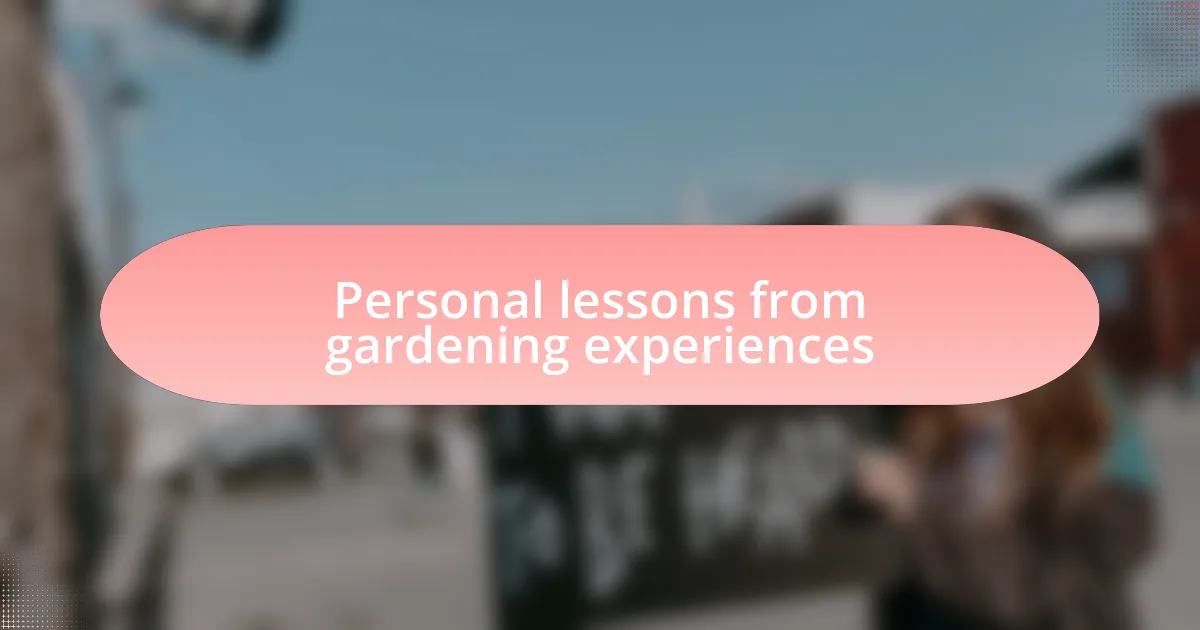
Personal lessons from gardening experiences
One significant lesson I learned from gardening is the importance of patience. When I first planted my vegetable seeds, I was eager to see immediate results. I remember feeling disheartened when nothing sprouted right away. However, witnessing those tiny green shoots emerge after weeks of care taught me that growth takes time. Have you ever felt that sense of anticipation when waiting for something to flourish? It’s a powerful reminder that nature’s pace doesn’t align with our own.
In another experience, I discovered the joy of diversity through experimentation. When I decided to plant various herbs in a small plot, I never expected the fragrance and flavors to intertwine. One day, as I made a simple pasta dish with my homegrown basil and oregano, the aromas filled my kitchen and brought back memories of family gatherings. Doesn’t it feel wonderful when the fruits of your labor remind you of cherished moments? This diversity not only enriched my meals but also reminded me that variety can lead to unexpected joys.
Lastly, I’ve realized that gardening is a fantastic teacher of resilience. I faced a significant setback when a late frost wiped out many of my young plants. It was disheartening, but instead of giving up, I learned to adapt. I re-planted what I could and adjusted my gardening calendar. How often do we need to adjust our plans in life when faced with setbacks? For me, this experience underlined the value of resilience and the importance of getting back up, no matter the challenges.
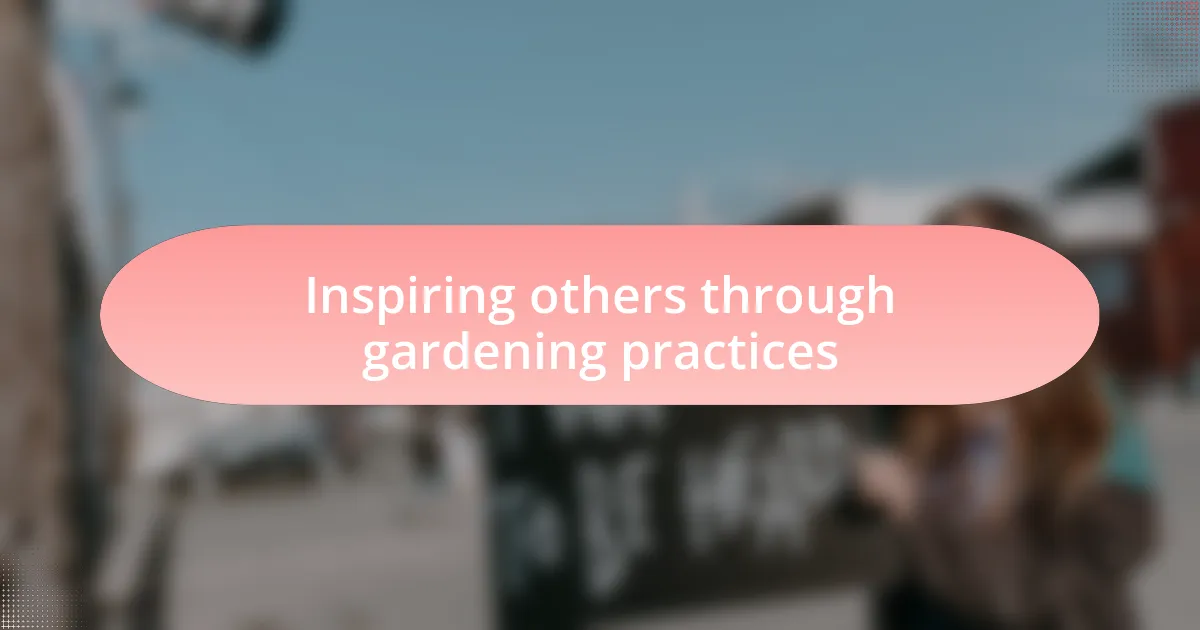
Inspiring others through gardening practices
Sharing gardening practices with others can ignite a passion for sustainability in our communities. I remember hosting a small gardening workshop in my neighborhood. As I demonstrated how to create a compost bin, I could see the interest in people’s eyes. The conversation flowed as we exchanged tips, and I realized that my simple act had encouraged others to embrace eco-friendly habits. Have you ever witnessed someone discover a newfound love for nature? It’s incredibly rewarding.
Each time I share my gardening experiences on social media, I receive messages from friends asking for advice on starting their own gardens. One friend, in particular, was hesitant at first, convinced she didn’t have a green thumb. However, after a few weeks of growing her own tomatoes, she called me, bubbling with excitement about her first harvest. In that moment, I understood how important it is to inspire others—her joy was contagious and reminded me that we all have untapped potential waiting to blossom.
Gardening also compels me to connect with local schools, where I guide students in planting their vegetable gardens. I recall the bright smiles and the laughter that filled the air as kids dug in the soil for the first time. Their curiosity was infectious, sparking questions about the role of insects and plants in our ecosystem. This interaction not only motivates them to learn about biodiversity but also helps them understand their place within nature. How can planting a single seed inspire a future generation? I’ve come to see that every garden can tell a story and inspire change.